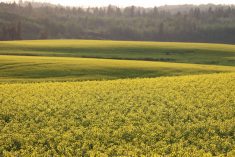If the U.S. plans to fill the gap created by slamming the door on Argentina and Indonesia, it may need Canadian canola
A biodiesel dispute involving the United States and other countries could end up boosting demand for Canadian canola oil, depending on how it plays out, says an analyst.
The U.S. Commerce Department has issued preliminary countervailing duties against biodiesel from Argentina and Indonesia. Preliminary determinations from the companion antidumping investigation are expected in October.
The countervailing duties amount to 50 to 64 percent on imports from Argentina and 41 to 68 percent on biodiesel from Indonesia.
“The commerce department has recognized what this industry has known all along, that foreign biodiesel producers have benefited from massive subsidies that have severely injured U.S. bio-diesel producers,” Doug Whitehead, chief operating officer of the U.S. National Biodiesel Board, said in a news release.
Read Also

Critical growing season is ahead for soybeans
What the weather turns out to be in the United States is going to have a significant impact on Canadian producers’ prices
The U.S. imported 1.68 billion litres of biodiesel from Argentina in 2016 and another 386 million litres from Indonesia. Combined, that is a 464 percent increase from 2014 levels.
Those imports have taken 18.3 percent of market share away from U.S. manufacturers.
Arlan Suderman, chief commodities economist with INTL FCStone, said the preliminary duties have shut down imports from those two countries.
The big question is who is going to fill the void?
If U.S. biodiesel manufacturers filled it, they would need to find alternative feedstock supplies.
“We don’t have enough soy oil to meet the (new) demand,” he said.
“That would suggest that we will need canola oil if in fact we are forced to produce all the biodiesel here.”
NBB spokesperson Rosemarie Calabro Tully doesn’t believe imports will come to a grinding halt despite the punitive duties.
However, if it does result in in-creased demand for U.S. biodiesel, that shouldn’t be a problem. There is 15.9 billion litres of biodiesel production capacity in the U.S. market but only about 7.6 billion litres of actual annual production.
“There is massive underutilization of existing plants that could be brought online,” she said.
Many plants are running at about two-thirds of their capacity because of competition from low-priced imported product, said Calabro Tully.
Suderman said the United States may have a lot of capacity on paper, but there is considerable debate about how much of that could be brought online because some of it is from outdated or mothballed facilities.
He believes some of the additional demand will be filled by imported biodiesel from the European Union.
In 2013, the EU imposed anti-dumping tariffs of 22 to 25.7 percent on biodiesel imports from Argentina, forcing exporters to find new markets in the U.S.
Last year the World Trade Organization ruled those duties were illegal. There are rumours the tariffs will be reduced later this month.
Suderman believes that will result in the increased movement of Argentine biodiesel to the EU and perhaps some displaced product from the EU finding its way to the U.S.
That would eliminate some but not all of the potential new demand for soy and canola oil.
“There is a lot of question marks in the industry where nobody knows how this (new demand) is going to get filled,” he said.
“Nobody knows for sure. That’s why the market hasn’t just exploded.”
The NBB expects the commerce department will make its final determinations later this year or in early 2018. A determination by the International Trade Commission will follow.


















